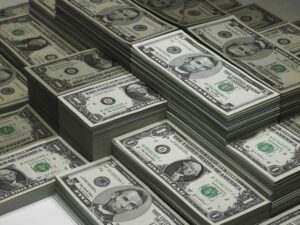On Monday, Japan’s yen fell to its lowest level in nearly two months, reflecting broader losses among major global currencies. The U.S. dollar continued to strengthen after Friday’s strong U.S. jobs report and increasing tensions in the Middle East.
The yen briefly touched 149.10 per dollar, the weakest since August 16, before recovering slightly to around 148.40. This followed a significant 4% drop last week, marking its biggest weekly decline since 2009.
The U.S. dollar’s rise came after a robust U.S. jobs report showed a surge in employment for September, a lower unemployment rate, and higher wages. These factors point to a resilient U.S. economy, prompting markets to reconsider the likelihood of upcoming Federal Reserve rate cuts.
Chris Weston, head of research at Pepperstone, noted that the combination of strong U.S. economic data, China’s liquidity measures, and optimistic earnings expectations has given a boost to both the equity market and the U.S. dollar. However, ongoing geopolitical concerns, such as potential energy supply shocks, continue to weigh on market sentiment.
Middle East Tensions Escalate
In the latest geopolitical developments, Israel targeted Hezbollah positions in Lebanon and the Gaza Strip on Sunday, just before the one-year anniversary of the October 7 attacks. This escalation followed Israel’s defense minister’s declaration that all options remain on the table against Iran. Despite these tensions, markets have yet to see significant shocks that could impact trading sentiment.
Oil Prices and Global Currency Movements
Brent crude oil futures dipped 0.4% on Monday, though they surged more than 8% last week, the largest weekly gain since January 2023. Meanwhile, the dollar index, which measures the greenback against major peers, remained flat after a 0.5% rise on Friday, logging over 2% gains for the week—the highest in two years. The euro slipped 0.06%, trading at $1.0970.
The yen’s weakness also stems from comments by Japan’s new Prime Minister, Shigeru Ishiba, which suggested that interest rate hikes in Japan might be delayed further.
Impact of U.S. Treasury Yields and Fed Rate Expectations
U.S. 10-year Treasury yields stood at 3.9711%, just below their two-month high. Early last week, yields dipped as investors sought safe-haven assets following Iran’s missile attacks on Israel. Market expectations now suggest a 98% chance of a 25 basis points (bps) Federal Reserve rate cut in November, down from earlier predictions of a 50 bps cut, based on CME’s FedWatch tool.
Economist Ryota Abe from SMBC Singapore predicts that the dollar-yen pair will remain between 145-149 in the coming weeks, especially given reduced expectations for a substantial Fed rate cut and Japan’s dovish stance ahead of the general election on October 27.
Sterling and New Zealand Dollar Outlook
The British pound remained flat at $1.3122, following a 1.9% drop last week, the steepest since early 2023. Bank of England (BoE) Chief Economist Huw Pill signaled a cautious approach to rate cuts, while BoE Governor Andrew Bailey hinted at more aggressive rate-cutting measures.
The New Zealand dollar edged up 0.1% to $0.6166, stabilizing after a week-long decline ahead of the Reserve Bank of New Zealand’s (RBNZ) policy meeting on Wednesday. Analysts expect a half-percentage-point rate cut as the RBNZ continues its easing efforts after rates hit a 15-year high.




















